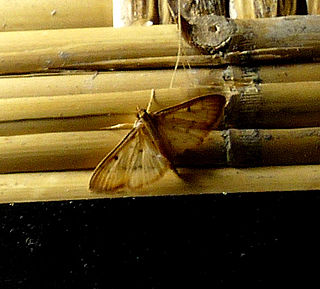| Glyphodes bitriangulalis | |
|---|---|
| Scientific classification | |
| Kingdom: | Animalia |
| Phylum: | Arthropoda |
| Class: | Insecta |
| Order: | Lepidoptera |
| Family: | Crambidae |
| Genus: | Glyphodes |
| Species: | G. bitriangulalis |
| Binomial name | |
| Glyphodes bitriangulalis Gaede, 1917 | |
Glyphodes bitriangulalis is a moth of the Crambidae family described by Max Gaede in 1917. It is found in South Africa (Gauteng) and Zimbabwe. [1]

Moths comprise a group of insects related to butterflies, belonging to the order Lepidoptera. Most lepidopterans are moths, and there are thought to be approximately 160,000 species of moth, many of which have yet to be described. Most species of moth are nocturnal, but there are also crepuscular and diurnal species.

The Crambidae are the grass moth family of lepidopterans. They are variable in appearance, the nominal subfamily Crambinae taking up closely folded postures on grass stems where they are inconspicuous, while other subfamilies include brightly coloured and patterned insects which rest in wing-spread attitudes.
Max Gaede was a German engineer and entomologist of international fame who described several hundred of new species of Lepidoptera, mainly African Noctuidae.
This species has a wingspan of 26 mm and looks close to Glyphodes boseae Saalmüller, 1880 and Glyphodes mascarenalis de Joannis, 1906. [2]

The wingspan of a bird or an airplane is the distance from one wingtip to the other wingtip. For example, the Boeing 777-200 has a wingspan of 60.93 metres, and a wandering albatross caught in 1965 had a wingspan of 3.63 metres, the official record for a living bird. The term wingspan, more technically extent, is also used for other winged animals such as pterosaurs, bats, insects, etc., and other fixed-wing aircraft such as ornithopters. In humans, the term wingspan also refers to the arm span, which is distance between the length from one end of an individual's arms to the other when raised parallel to the ground at shoulder height at a 90º angle. Former professional basketball player Manute Bol stands at 7 ft 7 in (2.31 m) and owns one of the largest wingspans at 8 ft 6 in (2.59 m).
Glyphodes boseae is a moth of the Crambidae family. It was described by Max Saalmüller in 1880 and it is found in Madagascar.
Glyphodes mascarenalis is a moth of the family Crambidae described by Joseph de Joannis in 1906. It is found in the Indian Ocean on the islands Mohéli, Réunion, and Mauritius.



